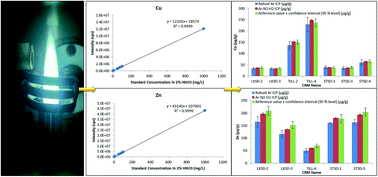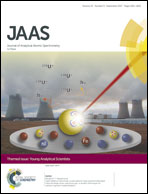Towards the reduction of matrix effects in inductively coupled plasma optical emission spectrometry: an argon–nitrogen–hydrogen mixed-gas plasma for the analysis of geological and environmental samples†
Abstract
An argon–nitrogen–hydrogen mixed-gas plasma was optimized towards the minimization of matrix effects in inductively coupled plasma optical emission spectrometry. Analyte sensitivity was enhanced by a factor of 1 to 4 (n = 26 elements) upon adding 3.7% v/v N2 to the plasma gas and 1.1% v/v H2 as a sheath around the Ar nebulizer gas flow in the central channel. However, detection limits were on average similar when using the mixed-gas plasma versus the Ar plasma, although at least 2-fold improvements resulted for Al and Ca in presence of 5% m/v Na. The 8.9 ± 1.7% (n = 26 elements) analyte signal suppression with an Ar plasma in a 0.23% m/v (or 0.1 M) Na matrix was reduced to 5.6 ± 2.3% with the mixed-gas plasma. The mixed-gas plasma was significantly more robust, with a Mg II/Mg I ratio of 13.3 ± 0.1 (n = 5 replicates), compared to 9.87 ± 0.16 for an Ar plasma optimized for robustness. The plasma excitation temperature also increased by 717 K for the mixed-gas plasma, confirming the improved excitation conditions. The superior analytical performance of the robust mixed-gas plasma for complex sample matrices was demonstrated through the direct quantitative multi-elemental analysis of a variety of certified reference materials (i.e., lake sediment, till, stream sediment, and natural ore digests), without internal standardization or matrix-matched calibration.

- This article is part of the themed collections: JAAS Recent HOT articles and Young Analytical Scientists


 Please wait while we load your content...
Please wait while we load your content...